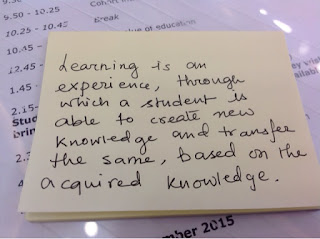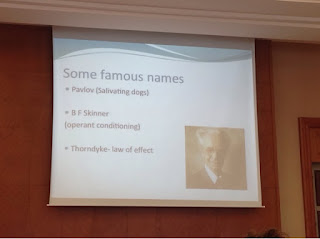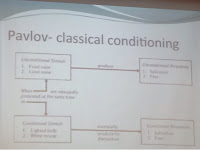Reflection day 1:
( picture credits to the IB Asia Pacific conference 2015 , Macau )
The conference day started a bit chaotic for me as I got late from the start itself. The first keynote speech had started. As I sneaked into the session , what I gathered from the sentences was that we were focussing on creative school. We focussed on why we should be a creative school and then looked on methods of how we can become one. The thoughts and research work of Dr. Michael Anderson came alive on a wall as posted here. The thoughts resonated with what Ms. Julia Gillard, the ex prime minister of Australia had instilled in us in her speech yesterday.
Both the speeches, focussed on why we needed humans in a futuristic society. A society where robots would be employed not only to do mechanised repititive work but also be used for caring and service sector and jobs will become redundant. Well the answer was probably we would be needing humans who are creative thinkers and can engage with these machines with better competencies to use them in a meaningful way. And thus arised the need of creative thinking and innovation in the present education system.
What these speeches meant to me and the implementation of the DP at my school?
For me critical thinking was always the crux, but here I stand at a complete different level where creative thinking is even more powerful and of higher order.
Dr. Anderson's speech strengthened my thoughts on having more relevant group 6 subjects in the DP curriculum offered and all the more relevant in the context of China. As a candidate school we have already set in the music, visual art and film studies on offer. Theatre would be another way of making the students here, acquire more creative skills in language.
Rethinking on designing the curriculum, integrating the Components of international mindedness and ATL skills with a creative framework in mind. Being affected by the recent workshop by Rob Bowden on learning through the values, integrating the same would also mean a lot.
Breakout session 1:
This was on web literacy for educators and schools. I had to attend this forcefully as all other sessions were full. I felt that being a tech enthusiast and setting practices so strongly in my previous school, I knew a lot. However attending this session I realised that there was so much I did not know too.Many things which seemed to be the heart of tech integration was so missing and those bits and pieces that I was introduced to would make the picture complete.All sessions on value integration kind of opposed tech, and majority of people do not pick up this discussion as they feel that the humane touch and connection is vanishing. And here this session was talking of internet connecting the computers and web connecting people. Indeed when we try to think of a futuristic education, why do not we feel that in future the way we are humanly connected with a person might also change?
I can so connect with my PLN network members and IB people, when I see there small profile picture and name on a social media or IB platform. But being in front of them would make me feel so disconnected. So indeed the use of web diligently and connecting to humans, does have a humane touch in it.I wonder is the value integration missing when someone posts and shares the need of a group of blood, or raises money through a facebook page for a medically ailling person , or raises awareness for an issue. Aren't we talking of a future of humans of working in a far more collaborative manner with machines in future by Julia Gillard?

Also came in a wealth of information of how the presenter uses platforms like common sense media, MOOC, coursera etc to teach web literacy.
How I would connect it to my implementation in the DP programme?
The diploma programme has its key requirement of raising awareness of academic malpractices and importance of academic honesty. The various portals that the presenter raised in terms of even checking the digital footprint by universities in future meant a lot for my programme implementation. In the context of China I saw tremendous potential in the platform of common sense media as a starter for my research skill orientation of students and steps to move towards a digital citizenship.
Breakout session 2 and 4:
The reason I am writing about these two sessions combined is that that I had chosen the two because of the presenters rather than the topic. UWC schools had always been my idea of visualizing a benchmark IB school whose core values , mission and vision always seemed to be far larger than IB.
Session 2 was on "conversations cost nothing: shaping a professional culture in your school" and session 4 was on "the secret principal : stories of international school leadership from behind closed doors".
Both the sessions just reconfirmed my belief on UWC schools being benchmarks in IB education. These sessions had evidences to support my belief which now seems almost like a biased knowledge claim of TOK . While the first session talked about setting up strong converstations with the staff, providing a leadership for learning atmosphere in the school culture.
It made us think on the seven norms of collaboration of which the seventh one seemed to be so relevant and the most important. As a deputy head of school in my previous school in India, I Could now connect and reflect on the practices that I had set in on similar lines. However, now I know after attending the session on leadership in the cultural context , yesterday that , being an Indian, paraphrazing is sometimes a challenge.
The session suddenly made me gleam with ideas of strengthening the existing practices of my school.The fourth session had stories from successful principals sharing on what challenges they faced and what strategies have been emplyed to overcome that.
A very simple model explained it all. I liked the stress on investment in organisational capital, building on structure in the administrative practices, as teachers felt secure and comfortable in such work cultures. I laways had a feeling better leaders were not better managers, but it was equally important to be one.
What all of this means to the implementation of the programme in my school?
As I reflect on my learning from these sessions, few questions keep coming to my mind?
What made me feel that the UWC principals and vice principals , in the two different sessions, from two diffferent campuses were connected?
What message did the two sessions commonly provide?
Well I felt that they belonged to an organisation with a shared vision and a goal. Yet the different contexts of operation gave them opportunities to set unique benchmark practices to support the achievements of these goals, which these leaders did so efficiently. Both sessions kept the teachers as the prime focus, contrary to my communication with other school principals who kept the learners in focus. I always feel that it should work like a cycle. If the leadership team kept teachers at the centre, the teachers along with the IB curriculum framework would definitely keep Learners at the centre and at the end both goals would be achieved. Happy teachers make happy learners.
Also what came out strongly of these sessions, that the presenters were not speaking just based on the biaseness of their own experiences , but backed their statements and strategies with examples of a research work that they had completed or was ongoing. Being a physicist it became so fluid for me to connect to those observed evidences.
So in continuation to the workshop that I attended on the start of the week on leading through values, what I gather and construct from all of this together is :
1. As my present school belongs to a bigger education group with a set of values and aims as articulated in the published book of our organisation "East meets west" , the same needs to lived up to in all the organisations of the group with an enhanced sense of connectivity
2. The already rolled out practices set in our school needs to be now connected to give a structure with a purpose and defined meaning for it's existence
Breakout session 3
The third session that I attended was the area that I was most passionate about. Connecting and networking and contributing to the development and benefit of the IB community with my acquired leadership skills.
It was "visualising the future: all programme network special session". I was excited as soon as I entered the session by seeing the chart papers and the colourful sticky notes. I am a kinaesthetic learner, who learns by constructing on my own. Just listening does not help me much in remembering in applying.
So here we had the 21st century constructivist pedagogy of the classrooms put to use with us , yet again in the context of a future that is so far away. We worked in teams to come up with some proposals to some framed questions that IB needed to work more on in the next phase , all related to the importance and impact of networking. In India I had seen the western India IB DP regional school network develop , gain recognition and been a part of it. Was fortunate enough to be an acting chair for the group for a brief period before I left India. Continuing as a dpc here in China , again gives me the wonderful opportunity to network and contribute.

The room seemed to be vibrant with ideas of what it would mean to networking in 2025? I Would say the way the exercise was set up had so much to teach about the pedadgogy in the classrooms.
How to generate authentic inquiry, how to engage learners, how to construct own learning and understanding, how to collaborate and use the learner variation in experiences and finally how to own all of that?
The final success was that everyone wanted the outcomes not by 2025 but by 2016.
To wrap it up I reflected on my strengths as a leader that I have acquired and concluded that I have started walking in a right direction. Need to incorporate all that I learnt to give shape to the leader in me in a different cultural context of China.
Share with me what has been your takeaway moments from the IB Asia Pacific Conference 2015.





















